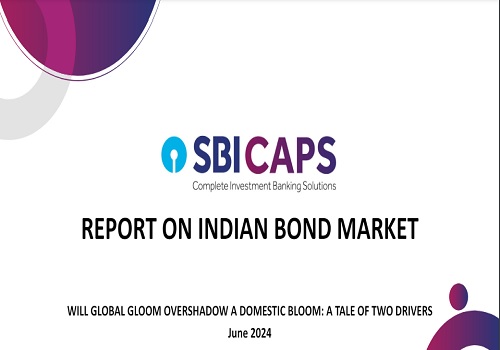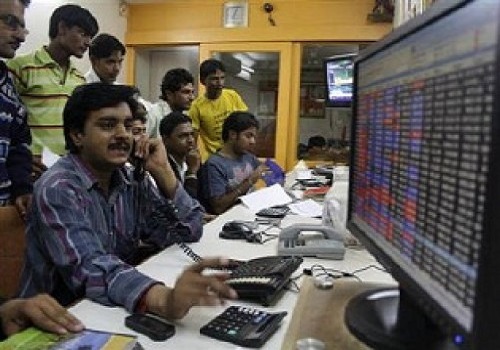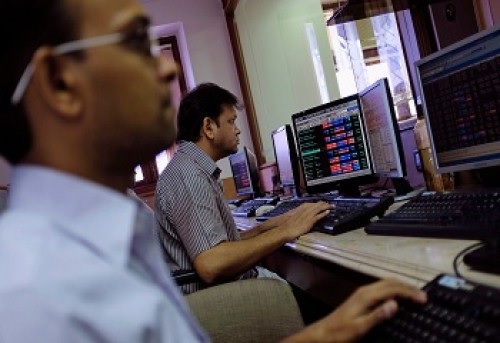SBICAPS Report : Indian Bond Market - Will Global Gloom Overshadow a Domestic Bloom: A Tale of Two Drivers

Executive Summary 1
Bond yields are an amalgamated indicator of disparate parts of the economy – from inflation, growth, fiscal balance, and external indicators which impact policy, to supply-demand dynamics, which add another layer of complexity. It is said that Central Banks have been able to fundamentally alter the nature of business cycles in the 20th Century using rates and yields. We stand again at a crucial point at the peak of the interest rate cycle, where not only the extent, but also the timing of actions shall have a deciding say in the future of yields (and the economy): thus, an investigation of their drivers in this Report is warranted
Consumer inflation on a steady descent helped by ebbing Core; slow pace of reduction to ensure headline remains above RBI’s target (4%) in FY25 at 4.7% y/y
* Headline inflation has been generally well-controlled since the Flexible Inflation Targeting (FIT) regime started in 2016. Barring brief periods in the COVID-19 era, Core inflation has been a downward tug on the headline in the past 5 fiscals, and has lodged itself durably below RBI’s 4% target since Dec’23
* Core likely bottomed out in FY24 and FY25 could see a gradual rise owing to pent-up base effects. Revision in telecom tariffs, soaring gold and silver prices, rising costs of healthcare, and jagged shelter inflation could influence the Core upwards
Fuel prices unlikely to be on fire bar supply shocks. Rainy relief from an above-normal monsoon critical to prevent food inflation festering
* Fuel prices have not played truant in the past few fiscals. The careful curation of duties has ensured gradual pass-through – helping cushion the outlook for FY25 with a high base. Globally, sufficient spare capacities exist with the OPEC, and volatility could mainly be induced by only geopolitical machinations
* Food inflation has exceeded headline for much of the large decade, despite an increasing base. While expectation of a good monsoon augurs well for kharif production, depressed pulses-sowing and volatile vegetables could play truant. However, policy has a limited role in leashing seasonal supply side shocks
Global growth prospects are improving but mixed economic data from the US suggests the Fed could be stuck between soft landing and hard take off
* Global growth outlook is sunnier than before, with Europe and China joining the US and punching above their weight. Things, however, remain highly dynamic with large divergence emerging between economies, and gargantuan general government deficits amplifying risks
* Seeing the US Fed’s past track raises questions about engineering a soft landing. Recent data suggest that pent-up pandemic era personal savings are running out even as the government’s bloated deficit limits wiggle-room for additional stimulus
Volatile economic variables have made the US Fed reactive rather than proactive: coupled with fickle Fedspeak, this has kept the market on its toes
* The US FOMC has kept changing its dotplot – from predicting 3 cuts in CY24 in Dec’23, it now predicts only 1 cut. The markets have also fluttered from 5-6 cuts in CY24 in Dec’24 to 1-2 cuts now. Nothing has an air of finality, however, and this could evolve rapidly depending on direction of inflation/growth prints
* Fedspeak also fluctuates with every datum and speaker. This acts as a strategic counterweight in balancing expectations between FOMC meetings sometimes but has also led to extreme volatility in US yields (US 10Y yields moved in a 120 bps range from Jul’23 till now, though rates have stayed unchanged!)
Executive Summary 2
Forex buffers shield India from minor global air pockets, but large-scale external turbulence remains a remote risk in the horizon
* The external sector is more robust than in 2013 when thin buffers coupled with rising crude precipitated a taper tantrum, forcing the RBI to raise rates to avoid sharp depreciation in the INR. While an orderly depreciation of the INR remains a possibility in FY25, we believe that sharp changes will be curbed
* Risks pertaining to high trade deficit remain in the realm of rarity, with only a combination of geopolitical shocks, distorted duty structures, and sharp global slowdown likely to make it crystallise in material measure in FY25
Steady but slow descent of inflation, robust domestic growth, and possible global risks largely mitigated by buffers, indicate rate cuts will start in Q3FY25
* The real rate (CPI – repo) is expected to reach 2.7% in Q2FY25. Though this remains below peaks reached in previous cycles, both the FY15 and FY19 cycles saw real rate peaking reaching ~2.7% around 3 months before the first rate cut, thus we expect rate cuts to start in Q3FY25
* In recent times, the Central Bank has chosen to carefully curate liquidity through several tools beyond the policy and stance, such as OMOs, buybacks, switch operations etc., which has allowed it to avoid demand side coupling of supply side inflation, while maintaining funds for productive uses
Union’s commitment to non-expansionary growth keeps fiscal consolidation in sight; increased State borrowing is a monitorable
* Blistering growth momentum has seen monotonic upward revisions to GDP estimates, and the outlook for FY25 remains robust at ~7.0% y/y real growth. The Union is likely to manage this while keeping borrowing in check, aided by a generous dividend from the RBI
* At the same time, States are expected to ramp up their gross borrowings to ~Rs. 10.5 trn in FY25, a 4% y/y rise, contrasting the declining trend in Union Gsecs. This will help temper the supply side constraint
Fresh global interest and robust growth in domestic investors in Indian G-secs is tilting the balance in favour of supply rather than demand
* Demand for Indian G-secs will see a fillip in FY25 due to inclusion in global bond indices once short-term liquidity issues in certain papers gets sorted. While this augurs well for keeping yields down, it could also induce some bouts of volatility
* Sharp credit growth from banks will ensure that demand for Union G-secs will outpace supply in FY25, just for them to maintain their SLR. The government has also altered its maturity pattern to suit patient investors such as insurers and pension funds, who form an increasingly large chunk of investor base
Above views are of the author and not of the website kindly read disclaimer






.jpg)














